#Logarithm examples
Explore tagged Tumblr posts
Text
Log Differentiation Ex. 3



Patreon
#studyblr#notes#math#maths#mathblr#math notes#maths notes#calculus#calculus notes#calc#calc notes#college calculus#calculus example#calc example#calculuc ex#calc ex#differentiation#logarithms#calculus differentiation#calc 1#calculus 1#calc I#calculus I
24 notes
·
View notes
Text
shells for witchcraft

Abalone Shells
Abundance, peace, and compassion
Abalone shells are very colorful, and the insides are coated with the same material that make up pearls, nacre. These colors are said to be incorporating all the colors of the sea and sky. In addition, the iridescent colors promote a feeling of abundance, peace, and compassion. In addition, the colors can represent the upper chakras, the Abalone shell is useful for developing psychic powers. Since Abalone shells have also been a food source for thousands of years, Abalone shells represent the giving power of the Ocean.
Abalone shells can also be made into jewelry and amulets, and not only will they promote abundance, peace, and compassion, but they will also impart a calming, spiritual vibration to help the wearer through emotional difficulties. In addition, Abalone shells have also been historically sacred in Polynesian and Native American cultures, especially as a vessel for sage while smudging.
Scallop Shells
Travel and spiritual quests
Symbol of Venus and Water
Scallop shells are distinguished from other shells by the multiple rays and ridges, which all converge at a single point near the base. To early humans, this likely symbolized the sun's rays converging on the horizon at sunrise or sunset. Because of this, Scallop shells are a good symbol of Venus, also known as the Morning Star or Evening Star. Later, to medieval Christians, the Scallop represented the path of pilgrims to holy sites.
Continuing, Scallop shells had a sacred meaning in Christian Europe from as early as the first pilgrims. The pilgrims, although mostly illiterate, were able to be guided to the pilgrimage sites with the Scallop symbol. In addition, the Scallop is a symbol of the Saint James the Apostle, and the symbol of the Scallop can be found through countless Christian altars and cathedrals. Because of the association with pilgrimage, the Scallop is a symbol for those who have undertaken a spiritual quest.
In addition, the Scallop shell is often depicted as the seat or carriage of ocean deities in art. For example, in art Poseidon often rides upon one, and Aphrodite is seen rising up from the sea in a Scallop shell. In addition, Scallops are often on Pagan altars to symbolize ocean deities and the element water. Because of this, Scallops are often used as a chalice, offering bowl, or vessel for love magick.
Nautilus Shells
Renewal, growth, and rebirth
The Nautilus travels hundreds of miles in the currents of the sea, and can be considered the nomad of the sea. In fact, the fitting name means "sailor" in Greek. More importantly though, the Nautilus shell is an important symbol of mathematics and sacred geometry because of the logarithmic pattern in its spiral.
This shape is because unlike other shell creatures, rather than shedding its shell and finding a larger one, the Nautilus increases the size of the shell. The Nautilus shell grows to create a larger chamber for the body as it grows. Because of this, the Nautilus shell is a good symbol of growth, renewal, and rebirth. Additionally, the outwards spiral trend of the Nautilus suggests that it can continue growing indefinitely. Meditate with a Nautilus shell or use it in your magick for spiritual growth and expansion.
Auger Shells
Protection and aggression
Auger shells are distinguished by its shape, which is an elongated spiral that has an opening at the base and a point at the tip. In the language of shells, the Auger is considered to be both masculine and feminine energetically, therefore representing completeness. There are hundreds of varieties of Auger shells all around the world as well.
In addition, Auger shells come from a type of predatory sea snail, and the aggression of the animal is implied by its narrowly focused shape. Auger shells have a venomous tooth as well, making it a good shell to use in hexes and curses. In magick, Auger shells are one of the only shells that are associated with the planet Mars. Other uses for Auger shells are for headdresses, magick wands, and protective charms.
Cowrie Shells
Fertility, luxury, and wealth
The Cowrie shell is characterized by its yellow or white color and egg-shape, with two rows of teeth along a gap in the center of the shell. Cowrie shells are admired for their natural polish, which symbolizes refinement and luxury. In fact, the Italian word for Cowrie is porcellana ("little pig"), which the word porcelain is derived from. Because of its shape and polish, Cowrie shells have been used as currency, decoration, and religious items in nearly every part of the world.
In addition, because of its shape, the Cowrie shell symbolizes the vulva. Therefore, the Cowrie shell is often used in charms regarding wealth and fertility. Cowrie shells can also be strung onto necklaces or sewn into garments. Additional uses for Cowrie shells include divination. There are many different systems of divination with Cowrie shells, mostly stemming from African and Afro-Caribbean cultures and traditions.
Conch Shells
Awakening and mermaid connections
Conch shells have been symbolically used by cultures around the world since ancient civilizations. The conch (or Shankha) is used by Tiben Buddhists as a way to call people to worship, and the conch shell is also seen in the hand of the Hindu god, Vishnu. In addition, the sound of blowing through a conch is similar to the sound of AUM (the sound of the universe), which has an awakening effect (similar to chanting OM).
In addition, the conch shell is often shown in the hands of mermaids, which makes the conch shell a good tool for connecting to mermaid energy and mermaid spirits. Similarly, blowing through the conch shell can be used as a tool for summoning mermaid (and other ocean creatures) spirits. Meditating with the conch shell can be a way to get in touch with the ocean and ocean spirits, since you can hear the ocean in the conch shell.
Sources:
https://www.groveandgrotto.com/blogs/articles/the-magick-of-seashells
https://zennedout.com/magical-uses-meanings-of-shells/
87 notes
·
View notes
Note
Can you do one about the Sea of Thieves water?

OK
so . there was a biiig long talk about this at siggraph one year!! you can watch that here if you'd like . in the time between me getting this ask and me fully recreating the water, acerola also released a great video about it . the biiig underlying thing they do and the reason why it looks so good is they are making a Really Detailed Ocean Mesh in realtime using something called an FFT (fast fourier transform) to simulate hundreds of thousands of waves, based on a paper by TESSENDORF
WHAT IS AN FFT - we'll get to that. first we have to talk about the DFT - the discreet fourier transform. let's say you have a SOUND. it is a c chord - a C, an E, and a G, being played at the same time. all sounds are waves!!! so when you play multiple sounds at the same time, those waves combine!!! like here: the top is all 3 notes playing together, so they form the waveform at the bottom!!
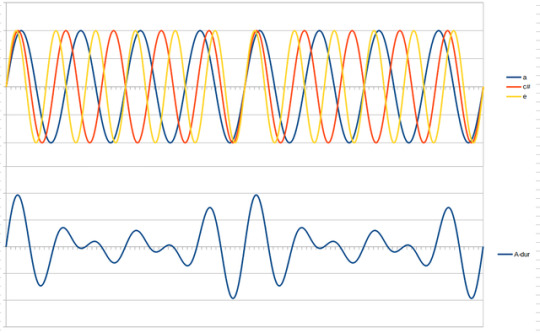
now if someone handed you the bottom wave, could you figure out each individual note that was being played? how about if someone handed you a wave of One Hundred Notes. you would think it would be very hard. and well, it would be, if not for the Discreet Fourier Transform.
essentially, there is a way to take a bunch of points on a waveform comprised of a bunch of different waves, add them all together, do some messed up stuff with imaginary numbers, that will spit back out at you what individual waves are present. i made a little test program at the start of all this: the left are the waves i am putting into my Big Waveform, the top right is what that ends up looking like, and all the little rainbow points on it are being sampled to spit out the graph at the bottom right: it shows which frequency bands the DFT is finding (here it is animated)
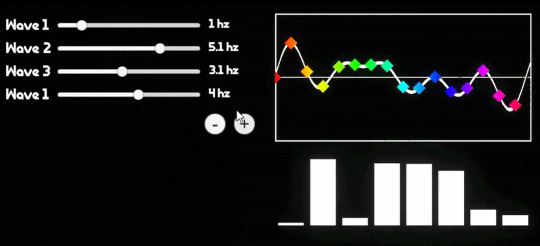
this has enormous use cases in anything that deals with audio and image processing, and also,
THE OCEAN
tessendorf is basically like, hey, People Who Are Good At The Ocean say that a buuuunch of sine waves do a pretty good job of approximating what it looks like. and by a bunch they mean like, hundreds of thousands to millions. oh no.... if only there was a way we could easily deal with millions of sine waves..........
well GREAT news. not only can you do the DFT in one direction, but you can also do it in REVERSE. if you were to be given the frequency graph of a noise for example, you could use an INVERSE DFT to calculate what the combined wave graph looks like at any given time. so if you were to have say, the frequency graph of an oceaaaan, for example, you could calculate what the Ocean wave looks like at any given time. and lucky for us, it works in two dimensions. and thats the foundation of the simulation !!!!!
BUT WAIT
as incredible as the DFT is, it doesn't scale very well. the more times you have to do it, the slower it gets, exponentially, and we are working with potentially millions of sine waves here
THE FAST FOURIER TRANSFORM here we are . the fast fourier transform is a way of doing the discreet fourier transform, except, well, fast. i am Not going to explain the intricacies of it because its very complex, but if you want to learn more there are a ton of good 30 minute long videos on youtube about it . but essentially, due to the nature of sine waves repeating, you can borrow values as you go, and make the calculation Much faster (from exponential growth to logarithmic growth which is much much slower, and scales very well at higher numbers). it's, complicated, but the important part is it's so much faster and the diagram kind of looks like the shadow the hedgehog story plot
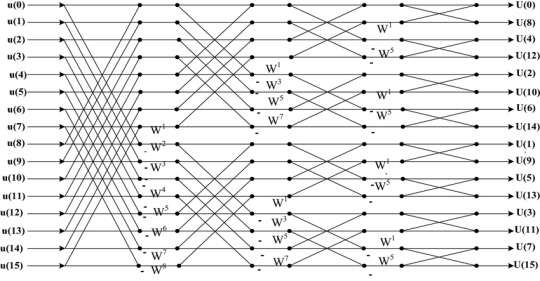
so if we use the inverse FFT on a graph of a rough estimate of what frequency of waves in the ocean (called a spectrum, basically tells us things like how many small waves, how many big waves, how different waves follow the wind direction. sea of thieves uses one called the phillips spectrum but there are better ones out there!!) now we have our waves !!!!!!! we can also use another inverse FFT to get the normals of the waves, and horizontal displacement of the waves (sharpening peaks and broadening valleys) through some derivatives . yayy calculus
OK MATH IS OVER. WE HAVE OUR WAVES!!! they are solid pink and look like pepto bismol. WHAT NOW

i cheated a bit here they look better than not being shaded because i am using the normals to reflect a CUBEMAP to make it look shiny. i think sea of thieves does this too but they didnt mention it in their talk. they did mention a FEW THINGS THEY DID THOUGH
FIRST OFF - SUBSURFACE SCATTERING. this is where the sun pokes through since water is translucent. SSS IS REALLY EXPENSIVE !!!!!! so they just faked it. do you remember the wave sharpening displacement i mentioned earlier? they just take the value where the waves are being sharpened and this will pretty naturally show off the areas that should have subsurface scattering (the sides of waves). they make it shine through any time you are looking towards the sun. they also add a bit of specular ! sss here is that nice blue color, and specular is the shiny bits coming off the sun. the rest of the lighting is the cubemap i mentioned earlier, i dont know if thats what they use but it looks nice !!!!!

then the other big thing that they do is the FOAM !! sorry i lied. there's more math. last one. you remember the wave sharpening displacement i Just mentioned. well they used that to find something called the JACOBIAN and well im not even going to begin to try and explain what it means but functionally what it does, is when the jacobian is NEGATIVE it means waves are clipping into eachother. and that means we should draw some foam!!! we can also blur and fade out the foam texture over time and continuously write to it to give it some movement, and bias this value a bit to make more or less foam. they do both of these!!!

YAYYYYY !! OK !! THAT'S SEA OF THIEVES WATER!!!!! THANKS FOR WAITING ALL THIS TIME. you can see my journey here if you would like to i have tagged it all oceanquest2023
thank you everyone for joining me :) i had fun
1K notes
·
View notes
Text
Snippet - Fate vs. Choice - Forward but Never Forget/XOXO

Jinx has a decision, and a deadline.
Forward but Never Forget/XOXO
Six o’ clock. Late evening.
The Cathedral of Progress.
Lanterns burned in their iron-scrolled brackets; the shadows cut flayed patterns on the granite walls. In the nave, the acolytes chanted, cloaked and cowled. In their palms, the lit tapers cast long, lean shadows across the stone floors. Their voices were a mechanized hymn: harmonized down to the smallest atom vibrating in the air. There was no music riding the currents. Only silence, draping a veil of total stillness over the congregation. Perhaps even eternal damnation, to those who dared trespass.
Jinx didn't give a ripe toot about damnation. She'd already fallen from grace: the moment she'd set a wind-up monkey loose to rescue her family, and jinxed them instead. Her own jinx, since that fateful night, was an inevitability, and a long time coming.
Now, at nineteen, she was the living, breathing epitome of it.
The harsh sweetness of coffee cut through the chants. Jinx cracked an eyelid open; for one long giddy second, the world spun in a sickening circle.
Then it righted itself. Or Viktor did: a cool hand clasping hers.
“Wake up, Jinx.”
Her eyes fluttered open. She lay, starfished in an indolent sprawl, in sweetgrass that swayed as if under an invisible caress. The aroma of lilies was ascendant; twilight had deepened their perfume. The night-garden was tucked into the courtyard at the heart of the Cathedral, abutted by a small cemetery of granite.
Under the surreal refractions of a stained-glass dome, it was a wonderland: teeming with long-dead saints, and the perfumes of late-blooming flowers, all a-glow in holy light. Upon closer scrutiny, the holiness inverted into the uncanny. Every plant, aspirating beneath the multicolored rays, was revealed to hold an almost numerical symmetry: logarithmic spirals of orchids, geometrically-profound petunias, grid-patterns of clovers all fractaling in golden ratios.
As if every organism—from soil grain to leaf tip—had coalesced into life under the touch of a divine hand. Or a very obsessive mathematician.
Or—both.
Then there was the tree.
It was a prehistoric sycamore of darkling wood: five times the height of the average Piltovan oculus; three times as broad across. The branches fanned out into spokes as big as a ferris wheel. The ends of each spathe, splayed wildly under the skylight, erupted into iridescent blooms. They were nearly gem-like in their purity: their crystalline petals glowing in colors of multicolored amethyst, chrysoprase, quartz, topaz, ruby. The canopy spread over the entire garden; the roots curled deep into the bedrock.
By nightfall, it gave off an eerie luminescence: bathing the garden in an ephemeral glow. By daylight, it cast a rainbow halo across the grounds. Its fragrance changed constantly: one minute pungent as wormwood, the next citrusy as lemon zest, another woody as cardamomh. Insects swarmed about its roots; butterflies flocked its boughs. Some even swore they'd spotted faeries dancing in rings beneath its shadow.
The hallucinogenic effects were, by Viktor's accounts, an ur-example of magicoreality: an object, space, or phenomenon that is created through the combined imagination of multiple entities. It was real, because they believed it real. And vice versa.
Like a mobius strip blossoming into being.
Viktor's acolytes had transplanted the tree—roots to stem—from Singed subterranean laboratory. Something in the soil of the Cathedral's grounds nourished it with unique potency: the tree flourished where naysayers, Silco chief among them, predicted it would rot. By the first month, it'd become the centerpiece around which every botanical beauty revolved. By the sixth, it was the brilliant heart of a preternatural paradise: creepers, ferns, lilies, ivies, marigolds, all erupting in a palette of purest life.
By the tenth?
The tree was worshipped as an entity unto itself. It dominated the cultists' rhetoric; it haunted their reveries. It was rumored that Janna herself had breathed life into its veins, rescuing it from the brink of collapse. Pilgrims from the depths below, voyeurs from the heights above, arrived in droves to seek the sheltering boughs as if for the same restorative breath.
And under those twirling branches?
They were never the same again.
Formerly pallid patients were rumored to stagger from their sickbeds, sit beneath the blossoms in solemn ceremony, then unfold from their atavistic comas miraculously reborn. Like larvae metamorphosing into butterflies.
From devolution to evolution.
But though the tree restored a measure of life to its devotees, its own was an hourglass suspended between grains. The fruits hanging off its branches evoked a spectrum of incandescent sea-shells washed by whitecaps onto arid shores. They were entirely inedible; ash and air. And as soon as they fell, their shells fossilized: petrifying into stone-crusted facets within minutes of detachment, before dissolving into inert dust.
It was the tree's perpetual paradox: the promise of life, forever beyond reach. And death, ever-encroaching at its heels.
In its shadow, Viktor, the most devoted disciple of one, held court weekly with the most notorious apostate of the other.
"Wake up, Jinx."
Viktor's hand, freed from its tight leather glove, squeezed hers. His fingers, long and thin, held a delicate strength: there were calluses, velvety, at the tips, and a roughness along the heel. A scientist's hands, evolved into a healer's. Tonight, Jinx saw ink smudges on the knuckles. There was also a tiny nick, from wielding a scalpel during the evening's surgery on a young boy's ruptured appendix.
The boy was safe. Tucked into a cot at the infirmary, with the others under Viktor's care: each dosed with enough poppy-milk to see them through the night. The boy's mother, one of the dozen souls who'd flocked to the Cathedral seeking the Machine Herald's aid, had wept at her son's restoration, kissing the hem of Viktor's robe in a show of gratitude.
It was a scene that Jinx had witnessed, over and over again, during her visits. And it never failed to unsettle.
Devotion, undiluted, had that effect. Especially when it was devoid of desire.
Daily, scores of souls passed in and out of the Cathedral. Each brought with them a problem, a poison, a plea. Each, Viktor addressed in their turn: salving their sores, purging their pustules, and bestowing, with a steady hand and a soft voice, his personal brand of salvation.
He never charged for his chem-modifications. Even the most complex, which took months to design, were given for free.
His payment, his only payment, was everything.
From the start, he’d made plain that his services were offered on a strictly non-partisan basis, and would cease immediately should any faction in Zaun attempt to co-opt his work. Except that was a lie. Everyone knew, in Zaun's hierarchical honeycomb, Viktor had no love for politics. But he was fiercely political: his sacrifices, solely and exclusively, were for the elevation of Zaun's future.
It was his singular obsession: the evolution of the present into an age of transcendence, and the eradication of the past into obscurity.
Viktor hated the past. A past that’d left him broken, disfigured, discarded: an imperfect specimen, unworthy of survival.
The same past, which had yet forged him.
And Jinx, his muse and mirror, who'd been reborn in its bloodshed.
"Jinx," Viktor repeated. "Wake up."
His hand squeezed hers, then let go. A moment later, a metal cup was pressed into her grasp.
The warmth radiated; Jinx's flesh drank it up. The coffee gave off its curls of aromatic steam: a nutty blend of chicory root, black chocolate liqueur, and the sweet whiff of anise.
Diluted, as always, with sweetmilk.
Viktor, his own cup balanced precariously between two fingertips, reclined with an easy elegance in the grass. His staff lay within arm's reach: the undying habit of a boy whose mind is always five steps ahead, but whose body is forever falling behind. Everywhere, leather-bound books were scattered, some facedown with cracked spines, others bristling with raven's feathers that doubled as bookmarks. An inkwell glittered, half-empty, on a stack of maps scribbled with notes.
In this garden, Vitya was ever-studying, ever-searching. Never satisfied with the knowledge already in hand, and the miracles already in motion.
Something he and Jinx shared in common.
Reclining on elbow, Viktor sipped from his cup with the other hand. Then he plucked a notebook from the pile, stirred through its pages with a fingertip, and resumed writing with his cockatrice quill: a rapid series of symbols that, unfurling, imprinted themselves in a secret pocket of Jinx's brain, and the darkest recesses of her heart.
Destiny: charted beyond the stars.
Jinx sat up, knees tucked against her chest, and drank from her cup. The flavor was just as it should be: bitter chased by sweet, complexity balanced by simplicity.
Viktor's handwork: the paradox distilled into metaphor.
Just like the garden, where every blade of grass grew exactly the same height, and every flower, in its arrangement, was a repetition into infinity.
Sipping, Jinx's eyes flicked from bloom to bloom. Then, she noticed:
A single blossom out of place.
A lone iris, curling its way from between the tree's roots. It was sly as an intruder, bright as a fallen star.
The same hue as Powder's wishful blue eyes.
Jinx's lips curled. Tentatively, she reached out. Her fingers traced the blossoming petals. They were silky, smooth. Almost too flawless to be real.
"Is this place," she whispered, "alive?"
It was only half-joking. During each visit, she could never escape the sense that the garden—multiform, deviant—was suffused with a spiritual awareness sister to sentience. And the tree, gathering them both under its protective penumbra, was rooted right to the crux of Zaun's stony heart.
"Not exactly," Viktor replied, without looking up from his notes. "Not by our reckoning. More a kind of... meta-life."
"Meta-life?"
Viktor, dipping the quill in its inkwell, shrugged.
"This tree is but a reflection—an iteration—of something larger-than-life. Something of a piece with the city's vital flow. A conduit of sorts."
"Like, what? A portal?"
"Perhaps," he said, and absently rested a palm on his leg, the site of his first augments. "Or perhaps a lens. Something which reflects, refracts, magnifies. An imperfect metaphor."
"Serpent's tongue. Apple's flesh. Devil's promise."
"Precisely. A system of shorthand within which meaning can be imparted, and context given."
Jinx's eyes lingered on the flower: a star's winking light, buried under layers of soil.
"What's the point, though?" she wondered. "I mean, yeah, I get it: a symbol's powerful. But if you're trying to forget the past—"
"Forgetting is not the same as erasing," Viktor corrected, patiently. "And what good is a symbol, Jinx, if no one knows what it stands for?"
Double-edged question and double-pronged answer: classic Viktor.
Sighing, Jinx returned to her cup. The coffee, cooled, had lost its bite. She drained it anyway, then let the cup rest in her lap. Her eyes, half-lidded, took in her companion.
He was still garbed for his duties: a mauve linen robe with a high collar, its sleeves rolled up, the hem draping past his knees. It was a garment, once, meant to conceal. Now, it served a purpose quite the opposite. Its folds bared the armature that held Viktor together: once emaciated, now elegantly streamlined beneath a segmented exoskeleton of synth-plates. His bad leg, encased in gleaming obsidian augments, now held the flexile precision of muscle, and the springing strength of a steel cable.
The fusion was seamless: the stuff of futuristic fairytale. When he moved, it was with an almost regal glide. As if, somewhere in the gaunt structure of Viktor's frame, there was an ancient drop of royalty, finally emerging from its hardscrabble shell in a blend of princely asceticism and common-born resilience.
Under the tree's canopy, Viktor's pallor was offset by his deep-hued robes. The effect wasn't peaky so much as pearlescent. His untidy curls tumbled freshly-glossed along his shoulders: the barest delineations of a beard teased the contours of his jawline. The sum total was neither masculine nor feminine. Only androgynous; ethereal.
Transcendent as stardust.
The rim's of Jinx's eyes burned. Why was it that even at their closest, Viktor seemed as if he was dissolving into astral orbit, a beautiful moon drifting farther from reach?
And why did Jinx feel herself hurtling on an opposing trajectory: crashing to earth with fatal velocity?
The wind, still unseen, sawed gently through the tree's branches. Its blossoms whispered: the susurration of silk sheets, or a lover's sigh. Jinx found it fitting that, though the Cathedral of Progress was, technically, the building's newly-christened designation, ordinary Fissurefolk referred to it, unofficially, by a different epithet.
The Resurrection Root. The Everbloom. The Glass Garden.
And the most popular—
Der Wunschbaum.
Ur-Nox for Wishing Tree.
Except Ur-Nox was a double-edged sword. It was the language of the ancients; Mages and Guardians who'd lived in the time before Zaun had ever been. Their language, therefore, was the language of enchantment: one half lofty, the other half sinister. Wish, for instance, was rooted in the word Wunschet: to want. To desire beyond the bounds of reality.
But it was also rooted in Wählen: to choose.
A wish could be a heart's deepest desire unlocked. Or it could be a will to power: to take what you want, no matter the cost.
And me? Jinx wondered. What do I want?
And what will I give to seize it—or throw it away?
At her silence, Viktor stopped scribbling. His eyes, deep-gold, met hers.
"All right, Jinx?"
"Y-Yeah."
"You should wake up."
"Don't wanna."
"No?" Scritch-scritch went the pen, runes blossoming in its wake. Distantly, Jinx heard the acolytes singing, a ghostly engine of harmony. And—could it be?—Sparky's yips, cutting through the choir: a dissonant counterpoint. The greedy mutt, somewhere, was begging for treats. "If you do not wake, how will your Name Day be celebrated?"
"Multitasking's a thing. I've always been a pro."
"You are terrible at multitasking."
"Am not!"
"You fell asleep during the surgery."
"You told me not to interrupt. So I closed my eyes. But I was listening. I always listen."
"You were drooling." And, closing the notebook with the coordinates plotted inside, he set it down. In a single graceful movement, he'd shifted closer. Close enough to touch his thumb against the corner of her lips, where a grin had stolen in. Viktor's own lips, palely-parted, were a few inches away. "You look like a child when you sleep. Peaceful. It is... rare."
"I was havin' a sweet dream."
"Oh? Tell me."
"A night full of stars. Wishes a-popping like fishes. And a beautiful boy." Her voice, at half-octave, came breathless. Always, his proximity did that to her: an unravelling of everything she held dear about herself. Like deja vu—except more desolate. Dying, when you longed to be reborn. "Except he won't wish me a Happy Name Day. He won't even gimme a kiss."
At that, Viktor smiled: a slow, secret curl that was yet the saddest expression in the world.
"Perhaps," he murmured, "he is a fool."
"Yeah?"
"And a coward." The thumb, tracing the full jut of her bottom-lip, was cool as snowfall, and as chaste. "Because he knows, deep in his heart, that you are still a child. The child he sees when you sleep. And because, despite whatever tradition or legality declares, you are not yet a woman. Certainly, not the woman who, once she comes into herself, will outrace him, and his grand designs, and fly off on wings of stardust."
"You talkin' about Silco?" Jinx quipped. "'Cause, no offense, but he's no competition. I can outrun that fossil anytime."
The levity fell flat. Viktor's golden eyes, augmented to their depths, lost their imperceptible luster. A moment later, his hand retreated, as if it'd never been.
"I know," he said, "that this is only an interlude."
"You think so?" Jinx, impulsively, caught the hem of his sleeve. "Pretty harsh frame to put 'round forever."
"Forever means little in a cosmos of infinite permutations."
"Not so long as we're still us, right?"
"A conundrum in itself." He didn't withdraw, exactly. Only laid his fingertips over hers, knotted into his sleeve. "Are our mirrored selves—in the physical, in the quantum—so very different at their crux? Is one less worthy, less agentic, than the other? Or are they simply two sides of the same coin, flipped endlessly, until the universe collapses on itself."
"Yikes. Talk about buzzkill."
"I am not a man for platitudes, Jinx." The smile, sadder, stayed on the surface. "Not will I feed you falsehoods, in hopes that the future may hold more than the present."
"So you say."
"So I mean." And, surprising her, he caught her hand in both his own: a tender clasp. "We've pledged our spirits as one. We've plotted our course. Escape velocity is inevitable. But the path ahead will not be easy. Not for either of us. If anything, it will be harder, given what we must renounce to see the destination through. And I—I cannot be sure—"
A crack in his faultless equilibrium. In turn, Jinx felt her own fragile serenity evaporate.
"Sure of what, Viktor?" she said, with quiet ferocity. "That I'll change my mind halfway? Chicken out before the starting gun goes off? Let Silco dictate my choices, like I've always done?"
"No, Jinx, no."
He shook his head; the curls danced, a ribboning cascade of cornsilk. There were silver streaks beginning to thread at the temples. Thirty-three, and a full-grown man where Ekko was still shedding the last vestiges of boyhood. But moments like this, it struck Jinx that Viktor was, at his core, even younger than Ekko. Two orphans prematurely thrust into roles before their time: the savior leading his flock to the promised land, and the savant saving souls that the world would sooner crush underfoot.
But both, in their hearts, still children. Still seeing Jinx, and what she'd become. But never, ever seeing her for who she was: the girl, not the legend.
The woman, not the jinx.
"Never that, Jinx," Viktor said. "Never would I think so little of you."
"...But?"
"It's been difficult, these past months, for us to speak frankly."
"Vitya," Jinx said, a touch exasperated. "We're speaking now. Aren't we?"
"We are." A squeeze, gentle, on her fingers. "At risk on both ends. But I have never once doubted your commitment. Your passion far exceeds mine; far exceeds whatever designs I may conjure. The world will be a better place, with you striving to make it so. My only fear is that, if you choose this path, yours will be the lonelier one."
"Lonely, how?" The ghost-prick of tears. "We're bonded, aren't we? Even if it's not what either of us planned—"
"A bond that can never be consummated. Never, in any sense, bear fruit." His grip tightened; yet the timbre of his voice held no rebuke. Only truth. "I am a creature born of disappointment, Jinx. Faulty in form and function. Unfit for any world except the one I will create, and even that shall be a long time coming. Yet, in the Void, you gave me a glimpse of paradise, and it was... indescribable. All I will ever want."
"And?" Her lip quivered, but held. A child, he'd called her, and yet her voice was steel. "Wasn't it enough? Wasn't I—?"
"You? Not enough? My dearest." Even though his sigh was bittersweet, a mote of passion shot through: the same passion that'd flowed, so effortlessly, between them in the otherworld. The same passion that now translated itself—sublimated and yet quartered—into the gentle dexterity of his hands on a circuitboard fused to a sobbing boy's flesh, and the consoling caress afterward as the boy's mother, sobbing too, laid a kiss of gratitude upon her savior's robe. "You are the only star in a universe without light. But because you are, you are far too much. For anyone's good. Least of all mine."
The tears, against Jinx's will, spilled free.
"So I was a mistake?"
"Yes. And no"
"How?"
"You were a miracle," Viktor said, and his smile, in its sadness, was radiant. "And a miracle is a gift bestowed by Fate. Without factors such as deservingness, or suitability, or even equity, thrown into the equation. A miracle, simply, is. As you, Jinx, always are. I know you've made your peace with our bond. You've acclimated yourself to it, the same as I have. But if we commit—truly commit—to the path ahead, we must renounce the rest, in every way. And Jinx... I cannot, in good faith, ask that of you. Not when I know what you stand to lose. Not when I know all the ways you need, and deserve, to be loved."
The tears kept falling. Jinx made no effort to stop them. The garden, with its Wishing Tree, was a time-out from pretense. Not sanctuary, but as close as Zaun's chaotic confines allowed. The other one—the Wishing Wagon, in civilization's shadowed cul-de-sac—was her true refuge. But that was a different her, with a different future.
A girl who'd yet to realize her greatest wish. A woman who, at the crossroad's fork, could take a chance.
She'd never told Viktor about the Wishing Wagon. Same way she'd never told Ekko about the Wishing Tree. Both were secrets within secrets: mirrored halves of a fractured whole.
And Jinx, at the liminal space in between, wondering: What's it mean?
What did it mean that one man had her soul at knifepoint, but another was holding her heart hostage? What did it say that she and Viktor fit together just right, but she and Ekko were built from perfectly mismatched puzzle pieces? What did it matter if she needed them both, but in ways so opposite they might as well be a different language?
How could she make the ends meet?
Especially when her life—her death—still hung on Silco's strings?
And her past—her future—still hinged on Vi's?
"Maybe," she said, and caught her lip in her teeth, "that's the point."
"Oh?"
"Maybe... the glimpse of paradise was all it was. A glimpse. The rest's about struggling to make it happen. Because it's the only way. Because choice is nothing but fate with a kick."
"Jinx, no."
"Why not? It makes sense. In a twisted sorta way." Her eyes, smarting-wet, blinked hard. "Fate's not a pretty delivery-gal on the front step with a package. He's a blind old pirate, throwing darts at a map and laughing as they land. Doesn't matter who gets skewered. Once that bullseye hits, it hits. And you're on the hook. No takebacks." Her other hand, lifting, aligned itself with Viktor's jaw: stubble yielding velvety beneath her palm. "We were always gonna be on the hook, Vik. At least, in the Void, I saw where we’re headed. What, in the end, we could become. And sure, the path's not a fairytale. But if we don't take it, the rest'll be fucked. And blind old fate'll be laughing his ass off, watching us sink under the waves."
"Perhaps," Viktor said, and leaned into her touch. But the smile, always, stayed sad. "But Jinx?"
"Yeah?"
"Fate is not the same as choice." Turning his head, he laid a kiss, pure as a snowflake, in the heart of her palm. "Even the cosmos, no matter its dictates, allows breathing-room for free will. I have mine, and I know what they will cost. Now, and in every incarnation. But you, Jinx: you are still so young. Your wishes, the ones that matter, have yet to be made. And once they are lost, you will not have the chance to reclaim them."
"Because I'm a child, right?" The anger, a flashfire that filled her to the seams, in this garden only left her aching. "Too dumb to know what I want. Too naive to make the tough call."
All at once, Viktor closed the gap.
Silently, he swept Jinx into an embrace: a cradle and a coffin holding both living and dead in sacred embrace. His arms made a crossbones at her shoulderblades; his breath stirred the top of her scalp. They were both clothed, but Jinx felt her heartbeat resonating through their ribcages, keeping time with the rhythmic dirge of the Cathedral's chants, and the Old Hungry's distant chimes
Reality and dream: melded into one.
Somewhere, Sparky was pawing at Jinx's slumbering shape in search of belly-rubs. Behind her eyelids, neon bled through. She heard fireworks; smelled engine-grease. Felt an odd pressure on her spine that had nothing to do with Viktor's cool fingertips tracing its curve, and everything to do with being bound, on a visceral level, beyond this communion they both shared.
"Fate," Viktor breathed, and his lips, against her temple, imparted prophecy, "will always come due. But choice? That, my dearest Jinx, is an arrow aimed straight for the heart. And to deny it: that is an error far graver than anything science, or the cosmos, could dole out." He kissed her forehead: the sweetest absolution. "Your choice must be yours. Do not allow a hand, no matter how divine, to dictate it."
Jinx, closing her eyes, lay her cheek to his chest.
"Not even yours?" she whispered, as the tears stopped falling.
"My hand, like my heart, will belong with you, Jinx. Even if you choose another path."
"Mirror, mirror on the wall."
"In every iteration," Viktor murmured, a tender withdrawal, "of this cosmic joke. An imperfect metaphor. Do you understand?"
"I do," Jinx lied, and lifted her face. "Kiss me?"
"This is not a space for secrets, Jinx."
"Then it's a perfect place, ain't it? 'Cause I won't have any left, after tonight."
"You will," Viktor said, and his thumbs smoothed the fading tear-tracks from her cheeks. "You do. We all carry secrets within ourselves. But to hide one, here, is to desecrate the very vow we must keep. And to deny our truth—any of our truths—is the greatest dishonor to the other. Do you understand?"
Foreboding rippled over Jinx's skin. The garden, the tree, the chants: all the beautiful trappings of ephemera, slipping like sand through the hourglass.
"Viktor." She caught his hand in hers, holding it fast. "Please."
"I'll see you tonight, Jinx."
"Don't—don't go—"
"Tonight. When you make your choice. Whatever that choice may be."
"But—"
"Wake up now."
The hourglass, upended. The Cathedral, the garden, the embrace, dissolving. All the dreamscape and its dazzling details, blotting out.
"Viktor!" Jinx cried. "Viktor!"
"Happy Name Day, Jinx," he said, and the ghost-imprint of his kiss died before it met her mouth. "I will kiss you, truly, tonight."
The ceiling spun above: a galaxy's worth of stars, winking out. Her hands, searching, found nothing.
Nothing but the blue iris, unfurling at the tip of a finger.
And Viktor's voice, deep as midnight.
"Make a wish."
The last winking star: her own.
#arcane#arcane league of legends#forward but never forget/xoxo#arcane silco#silco#forward (never forget)/xoxo#arcane jinx#jinx#arcane viktor#viktor#arcane ekko#ekko#jinxekko#ekkojinx#timebomb#jinx x ekko#ekko x jinx#vinx sciencebros#jinxtor
41 notes
·
View notes
Note
What are common keywords any game design resume should include?
It depends on the kind of designer position you're aiming for. We want to see key words for common tasks that those kind of designers have done. Here are some examples:

Common
Experience, craft, create, live, season, update, content, schedule, create, design, team, player, UX.
Level Design
Layout, place, trigger, volume, spawn, point, reward, treasure, quest, lighting, light, dark, texture, object, obstacle, blocking, whitebox, direct, draw, through, inviting, space, place, multiplayer, competitive, cooperative, co-op, deathmatch, capture the flag, ctf, domination, asymmetric, symmetric.
Quest Design
Text, reward, spawn, balance, level, pace, pacing, word, budget, localization, loc, narrative, item, itemization, dialogue, branch, spawn, difficulty, player, multiplayer, encounter, placement, place, trigger, chain, pre req, pre-requisite, condition, scripting, faction, seasonal, event.
Cinematic Design
Narrative, camera, character, blocking, screen, position, ease-in, ease-out, pan, cut, smash, storyboard, frame, framing, beat, cue, pacing, feel, shot, zoom, sfx, vfx, mark, contextual, conditional, quick time, event, timing.
System Design
Balance, numbers, formula, spreadsheet, excel, curve, quadratic, linear, logarithmic, growth, plot, level, power, over, under, even, normal, distribution, player, total, analysis, scale, scaling, script, scripting, math.

If you're at all familiar with the regular kind of duties and tasks that any of these kind of designers do on a regular basis, you'll immediately start to see how these words fit into describing what we do day in and day out. These are going to be the kind of words we see used to describe the sort of experience we expect to see on a resume/CV from someone who has done this kind of work before. We won't expect all of them in every resume, but we expect a good many of these words on the resume/CV of a reasonable candidate.
[Join us on Discord] and/or [Support us on Patreon]
Got a burning question you want answered?
Short questions: Ask a Game Dev on Twitter
Short questions: Ask a Game Dev on BlueSky
Long questions: Ask a Game Dev on Tumblr
Frequent Questions: The FAQ
28 notes
·
View notes
Text
For many years there has been intense discussion on the role and legitimacy of the jury vs the televote in the Eurovision Grand Final. The problem is that many of the arguments I see made are based on nothing but people's gut feeling and snap judgements from watching the show. And humans are notoriously terrible at intuiting statistics.
That's why I wanted to provide some actual data to give context to the more eye-catching examples people tend to use, and hopefully encourage some critical thought. I spent the afternoon updating my eurovision excel file with data from the 2024 and 2025 Grand Finals, and can now present these graphs of jury results plotted against the televote. As far as eurovision statistics go, this is one of the simplest charts you could make, and should hopefully be as simple to understand.
Terms: I use the term televote to refer to the entire public vote - this includes all votes from calls, texts, websites etc.
The axes: These show percentages out of the total number of jury or televote points awarded overall in a given show. Using this measure instead of the actual point scores ensures that results from different years are comparable, despite the fact that the number of Grand Final entries and overall points to be distributed between them varies from year to year (depending on the number of voting countries) .
Reference line: This shows where an entry would land if the juries and televote respectively awarded it an equal percentage of their available points. Data points that land above this line means the jury awarded the entry a greater proportion of its available points as compared to the televote, and vice versa. I find it interesting to see which entries land near this line, and then compare them to entries that stray further from it, in either direction. I also like to see where my favourites ended up, and consider how that can be understood in the context of the previous comparison.
First chart: Here each data point represents an individual entry in the Eurovision Grand Finals from 2016 to 2025 (aka every year with the current split scoring system). Data source: eurovisionworld.com

Second chart: These data points represent the average percentage out of the total jury/televote points each country was awarded between 2016 and 2025 (for the years that they made it to the Grand Final, that is).
Beware: For countries that made it to the final more times there are more data points to average, while for others there are as few as two results to work from.
Also beware: Averages can obscure variance - a country with epic highs and lows might end up looking similar one with stable middle-of-the-road results, despite their actual experiences being very different. That is to say: there are lots of outliers included in these averages - Spiders Georg has set up his cave and now lives in this chart. With his entire spider farm. Look at it. It's on the web.
Also-also beware: This chart makes the assumption that nationality is the most relevant variable to investigate in relation to the final result. But that remains an unproven assumption; before drawing any conclusions about potential biases the public or juries might have for certain countries, these results should be compared to charts where other factors are accounted for, to rule them in or out as compounding factors. Such factors could be running order, when the voting opens, genre, vocal ability, dancing ability, stage precence, visual production, creative cohesion etc.
In short, this chart doesn't rule anything in or out on its own—but it makes a good starting point for further investigation.

Country letter codes, for reference:

Not sure how viewable these charts will be on smaller screens, but for the lower scores on the detailed breakdown to be visible at all I needed to make them huge. Might fuck around and make the scale logarithmic at some point, to show more detail in the lower range without cutting off the upper. I also have more data tables with more complex calculations going on in this excel file. I might make charts of those at a later date, if I can first work out whether they provide any useful insights at all or were just fun to make. ¯\_(ツ)_/¯
Thanks for reading!
12 notes
·
View notes
Text
A True Friend
Caspian Keyes X GN!Reader
Word Count: 776
Requested: Anon @kalebell46
Request: On god please I need more Caspian Keyes fan fiction. This internet is so dry, there's like none out there. Could be of a him x reader while he's finding himself, the first real friend in his life that isn't there by the choice of someone else. And he'd be so paranoid about it too. Gooooodddddd please. AND I would love for a caspian fic please there are none

Caspian had been alone for so long, since he was young he had always been the outsider, the black sheep, the target and he thought that was how it was going to be for the rest of his school life. That is until he met (Y/N). Now (Y/N) for all intents and purposes probably wasn’t the best example for Caspian, they got into trouble, paid around and never listened to anyone who assumed that they knew better than them. Except when they were with Caspian, who they had only met because they needed tutoring.
(Y/N) wasn’t stupid though most people treated them that way, in fact they had a basic grasp on most things that were taught in class, they just didn’t seem to get it down on paper very well. Caspian was asked to tutor them and the rest followed with time, tutoring sessions turned into skateboard races and trips to the comic book store. Caspian learned quickly that his new companion was not stupid as he had heard a lot of the others in their year saying so he did make sure that some of their time was dedicated to bringing up his grades, in the end it didn’t matter though.
The world crumbled around Caspian as he found out about the real reason behind his birth, with his father gone and his mother keeping more of a watchful eye on him then usual, the only place he thought he might even be a little bit safe was with (Y/N) but then the thought crossed his mind… What if you had something to do with Logarithm's little experiment. That was why he stood outside your door hand hovering to knock, he jumped when you opened it smiling at him “what are you doing?” They asked “thought you were going to knock but you seemed like you were thinking about something.” They stepped to the side giving him space to come in but he didn’t move. “What?” “Are you really my friend?” He asked. “Really your friend?” They asked “of course I am.” “Really because I just found out a lot about myself that doesn’t make sense.” He answered. “Okay talk me through it.” They prompted stepping out and closing the door behind them. “I found something on my computer, they’ve been watching me.” Caspian answered. “They’ve been watching you?” They asked frowning, you were either genuinely confused or very good at acting. “Logarithms!” He answered more frustrated at having to explain himself at all. “Logarithms? Caspian you're going to have to start from the beginning if you want me to understand, remember I’m the slow friend.” They reminded him as he looked at you, that seemed to calm him down as he spoke again. “Don’t call yourself slow.” He grumbled, they shrugged as they looked at him waiting for him to continue. He took a second to calm down and then explained everything that had happened over the past few days.
It was easy to prove that you weren’t a part of it when you looked back at Stephen Holstroms life and realised that he didn’t have a best friend or a friend of any kind at Caspian’s age. (Y/N) was the only person that Caspian could trust but that didn’t mean that he wanted to drag them into everything that was happening, he still didn’t understand how they ended up in the car with him and Cary going to meet Maddie. “I’ll find a way to get you back home after all of this.” He promised. “Home?” They asked. “Why would I go home, you need someone right? Someone to trust?” “Yeah but-” “And we’ve proven that I can be trusted?” They asked. “Yes but-” “Then I stay.” they leaned back in their chair as Caspian glanced at her through the rear view mirror. “Why?” He asked. “Because I'm your friend, this is how friends work… Real ones anyway.” You shrugged. “Real friends?” Caspian asked. “Alright, how about this, I promise to be the one person that you can trust, a true friend, pillar to lean on and person to talk to, if you promise to stop thinking that you don’t deserve it. You didn’t ask to be made this way and no matter how you were born you are no less human than anyone else I know.” You said. “Alright, fine, as long as you don’t keep calling yourself the slow friend.” He answered. “Alright deal.” And that was the first time that he felt like he could trust someone, accept someone, turn away and they would still be there, a true friend he liked that security.
Request Here!!
#pantheon amc oneshot#pantheon amc imagine#pantheon amc#caspian keyes oneshot#caspian keyes imagine#caspian keyes#imagine#oneshoth#one shot#reader insert#x reader#gender neutral reader
23 notes
·
View notes
Text
Calm Among the Stars
Fandom: Sanders Sides
Pairing: Analogical; can be read as platonic or romantic
Word count: 490
Summary: With Virgil feeling a little pensive, Logan decides to keep him company using stargazing.
-
"You've been out here a while," Logan said as he cautiously approached Virgil, who was currently sitting on the grass in the yard staring up at the night sky.
"Yeah," came the quiet reply.
"Aren't you cold?" he asked.
"...yeah."
With a sigh, Logan summoned a thick blanket and, sitting himself down beside Virgil, draped it around both of their shoulders.
Virgil looked at him with surprise.
"Would you like to hear about some constellations?" Logan said simply.
Virgil huffed a laugh.
"Sure thing, Teach."
Logan straightened to attention, eyes shining with delight.
"Alright. Do you see that star right there? The one that's brighter than all the others?"
Virgil nodded, humming in acknowledgement.
"Well, that is Sirius, or the dog star, which is the brightest star in the night sky and part of the constellation Canis Major. It is actually what is known as a binary star, where two stars orbit one another and they can appear as a single body at this great distance."
Virgil made an interested sound to show he was still listening. He shifted to lean against Logan slightly, causing him to pause, smiling softly at the other.
"Now, moving up from Sirius, do you see that line of three stars right there?"
"Mm-hmm."
"That's Orion's belt. See the shape of his body? And there's his sword, his shield, and his club. Orion is particularly easy to find because the constellation has a number of especially bright stars. For example, Rigel, there, and Betelgeuse, right there, are among the brightest stars in the night sky and Orion contains six more stars with a magnitude below than 3. Where stellar magnitude is concerned, the smaller the number, the brighter the object."
"That seems a little confusing."
"Not really. It's a reverse logarithmic scale that was adapted from the original system proposed by Hipparchus, who defined the brightest stars as the first magnitude, the next brightest as the second magnitude, and so on."
"That's less confusing," Virgil said genuinely.
"Indeed. And because Orion is so easy to find in the night sky, it can be a useful tool for locating other constellations. For example, you can follow Orion's belt in the opposite direction from Sirius to find the Taurus constellation."
Logan glanced at Virgil from the corner of his eye. "Just like you can use the Big Dipper and Polaris to find the tail end of Draco."
"Draco is my favourite constellation! Dragonheart was a good movie," Virgil said, now seeming more present.
A stretch of silence passed between them, though it was a comfortable silence.
Finally, Virgil looked away from the stars and turned to Logan.
"Thanks, Logan."
Logan's eyebrows raised in surprise.
"You're very welcome," he said in a bemused tone.
"I'm ready to head back inside now."
Logan smiled, "Alright."
He stood up, offering Virgil a hand to help him do the same, and, together, they headed for the familiar warmth of the commons living room.
36 notes
·
View notes
Photo

2024 April 6
Unwinding M51 Image Credit & Copyright: Data - Hubble Heritage Project, Unwinding - Paul Howell
Explanation: The arms of a grand design spiral galaxy 60,000 light-years across are unwound in this digital transformation of the magnificent 2005 Hubble Space Telescope portrait of M51. In fact, M51 is one of the original spiral nebulae, its winding arms described by a mathematical curve known as a logarithmic spiral, a spiral whose separation grows in a geometric way with increasing distance from the center. Applying logarithms to shift the pixel coordinates in the Hubble image relative to the center of M51 maps the galaxy's spiral arms into diagonal straight lines. The transformed image dramatically shows the arms themselves are traced by star formation, lined with pinkish starforming regions and young blue star clusters. Companion galaxy NGC 5195 (top) seems to alter the track of the arm in front of it though, and itself remains relatively unaffected by this unwinding of M51. Also known as the spira mirabilis, logarthimic spirals can be found in nature on all scales. For example, logarithmic spirals can also describe hurricanes, the tracks of subatomic particles in a bubble chamber and, of course, cauliflower.
∞ Source: apod.nasa.gov/apod/ap240406.html
71 notes
·
View notes
Text

The Golden Ratio
Incorporating the concept of the golden ratio (approximately 1.618) into diet planning is an innovative approach, blending aesthetics and numerical proportions with nutrition.
The golden ratio, a mathematical ratio commonly found in nature, art, and architecture for its aesthetically pleasing properties, can also be creatively applied to diet planning.
Here's a conceptual framework for how one might do so:
*Visual Proportions on the Plate
Apply the golden ratio to the visual composition of your meals. For example, you can aim to fill approximately 61.8% of your plate with vegetables, fruits, and whole grains, while the remaining 38.2% could be allocated to proteins and healthy fats. This not only ensures a balanced diet but also makes your meal visually appealing.
*Macro-Nutrient Ratios
You could also apply the golden ratio to your macro-nutrient distribution—carbohydrates, proteins, and fats. Although traditional dietary recommendations might not perfectly align with the exact golden ratio numbers, you can aim to get close. For instance, you might try to consume a larger proportion of your calories from carbohydrates and fats (combined in a way that mirrors the golden ratio) with a smaller proportion from proteins.
*Caloric Distribution Throughout the Day
Consider using the golden ratio to plan the distribution of calories across your meals throughout the day. For example, if your daily caloric intake is 2000 calories, you could plan to consume about 1236 calories (61.8% of your daily intake) by the end of lunch and the remaining 764 calories (38.2%) for the rest of the day.
*Ingredient Ratios in Recipes
Incorporate the golden ratio into recipe ingredient amounts. For instance, when making a smoothie, salad, or dish, consider the volume or weight of ingredients in relation to each other following the golden ratio. This could mean using 1.618 times as much of one ingredient as another, creating both a balanced and aesthetically pleasing dish.
*Planning Eating Intervals
If you’re into intermittent fasting or planning your meal times, use the golden ratio to plan the intervals between eating. For example, if you prefer a shorter eating window, you might fast for 16.8 hours and eat within a 7.2-hour window, mimicking the ratio in a more abstract manner.
Incorporating the golden ratio into your diet is more about the approach to balance and aesthetics rather than strict nutritional guidelines. It encourages a mindful and visually pleasing way of preparing and consuming food, which can enhance the eating experience and potentially lead to more balanced meal choices.
********
Nature showcases the golden ratio in various forms, exhibiting its intrinsic patterns and designs that adhere to this mathematical principle. Here are some notable examples where the golden ratio is observed in nature:
* Spiral Patterns in Plants and Flowers: The arrangement of leaves, seeds, and petals in many plants follows the Fibonacci sequence, which is closely associated with the golden ratio. For instance, the spiraling pattern of seeds in a sunflower or the way pine cones are arranged can exhibit the golden ratio.
* Animal Bodies: The proportions of animal bodies often reflect the golden ratio. For example, the bodies of many species of fish and the spiral shells of mollusks (like the nautilus) follow this pattern. Even the positioning of facial features in some animals adheres to these proportions.
* Hurricanes and Galaxies: Spiral galaxies and the pattern of hurricanes showcase the golden ratio in their formation. The arms of spiral galaxies and the eye of hurricanes can exhibit spirals that mirror the golden spiral, which is a logarithmic spiral whose growth factor is φ, the golden ratio.
* Human Bodies: The human body has several examples of the golden ratio, from the proportions of the face and head to the ratios of limb segments and the structure of the fingers. For instance, the ratio of the forearm to the hand often approaches the golden ratio.
* Fruit and Vegetables: The way some fruits and vegetables grow or are structured can showcase the golden ratio. This can be seen in the way seeds are arranged in a fruit or the spiral patterns of growth in vegetables like romanesco broccoli.
The golden ratio is not a strict universal law governing natural forms but rather a recurring pattern that shows how efficiently nature organizes structures and systems. Its prevalence suggests an aesthetic and functional efficiency in biological forms and processes, a testament to the interconnectedness of mathematics and the natural world.
*****
Incorporating the golden ratio into cooking and food preparation through an esoteric culinary philosophy involves integrating the harmony and balance found in nature into your diet. This approach can add a layer of mindfulness and intention to the act of cooking and eating, aiming to align with the natural patterns for health and well-being.
Understanding the Golden Ratio
The Golden Ratio (Φ = 1.618…) is about balance and proportion. In culinary terms, this can translate to balancing nutrients, flavors, colors, and even the way food is plated.
Ingredient Proportions
- Balanced Meal Composition: Use the golden ratio to guide the proportions of different components on your plate. For example, making the ratio of vegetables (1.618) to proteins (1.0) in your meals, aiming to balance the nutrient density in favor of whole, plant-based foods.
- Recipe Formulation: Apply the ratio to the quantity of ingredients. For instance, in a salad dressing, use 1.618 parts oil to 1 part vinegar, or apply it to the ratio of spices to achieve a balance of flavors.
Food Pairing and Plating
- Visual Harmony: When plating your food, use the golden spiral as a guide for arranging the components attractively. Placing the main item and accompaniments in a way that visually represents the golden spiral can make the meal more appealing.
- Harmonious Pairings: Choose ingredients that complement each other not just in flavor but in nutritional content, aiming to create dishes where the sum is greater than its parts, adhering to a holistic balance.
Mindful Cooking and Eating
- Intentional Preparation: As you cook, focus on the process as a form of meditation, contemplating the natural beauty and balance in the ingredients and dishes you are preparing.
- Conscious Eating: Eat slowly, savoring each bite, and consider the nutritional balance and harmony in your meal. This mindful approach can enhance digestion and satisfaction.
Personal and Seasonal Harmony
- Align with Nature: Incorporate seasonal and locally sourced ingredients, aligning your diet with the cycles of nature. This not only supports sustainability but also connects you to the natural world and its rhythms.
- Adaptation for Health: Use the principles of the golden ratio flexible to suit your health needs and goals, ensuring that the concept of balance is also about what is harmoniously beneficial for your body.
Culinary Creativity
- Innovative Dishes: Let the golden ratio inspire you to create new recipes or tweak traditional ones, finding a balance between innovation and tradition, between simplicity and complexity.
Using the golden ratio as a guide in your culinary philosophy is more about adopting a mindset of balance, harmony, and connectivity with nature than about following strict numerical rules. It encourages a thoughtful, creative, and holistic approach to diet, aiming to nourish both the body and spirit.
*********
Adopting an esoteric culinary philosophy that incorporates the golden ratio into cooking and food preparation could offer several health benefits, primarily through fostering a deeper connection with food and promoting a balanced, mindful approach to eating. Here are some potential benefits of this approach:
1. Improved Nutritional Balance: By focusing on the proportions and combinations of foods that mirror the harmony found in nature, you might naturally lean towards a more varied and balanced diet. This can enhance your intake of essential nutrients, supporting overall health.
2. Mindful Eating Practices: This approach encourages mindfulness in the selection, preparation, and consumption of food. Mindful eating has been linked to better digestion, a healthier relationship with food, and possibly aiding in weight management.
3. Enhanced Appreciation for Food Quality: An emphasis on the natural aesthetics and ratios in food preparation can lead to a greater appreciation for high-quality, unprocessed ingredients. This could reduce the consumption of processed foods, potentially lowering the risk of chronic diseases.
4. Encouragement of Creativity and Experimentation: Engaging with food on a deeper, more esoteric level can stimulate creativity in cooking, which could make healthy eating more enjoyable and sustainable over the long term.
5. Stress Reduction: The act of preparing food with intention and a focus on balance may have meditative qualities, potentially reducing stress levels. Lower stress is linked to various positive health outcomes, including lower blood pressure and improved mental health.
6. Social and Cultural Connection: This approach can also foster a deeper connection to the food traditions of various cultures that have historically embraced the golden ratio and other natural harmonics in their culinary practices, possibly enriching your eating experience and cultural understanding.
7. Detoxification and Digestio: A diet that emphasizes fresh, natural foods and harmonious combinations may support the body's detoxification processes and improve digestion, contributing to overall vitality and well-being.
#golden ratio#food#at the table#homecooking#nutritional health#sustenance#cooking#culinary#esoteric#harmony
15 notes
·
View notes
Note
I am fascinated by you. What are the speeds of your processing units? Do you have more than one for each function? How accurately and precisely do you calculate? Along with basic arithmetic functions, can you run complex concept-based problems with integrated physics and chemistry, for example?
I have many questions.
– @coding-and-curry
[RESPONSE: UNIT S.E.N-KU_v1.03]
Inquiry received from @coding-and-curry (Subject: Sai Nanami) “I am fascinated by you. What are the speeds of your processing units? Do you have more than one for each function? How accurately and precisely do you calculate? Along with basic arithmetic functions, can you run complex concept-based problems with integrated physics and chemistry, for example? I have many questions.”
Acknowledged. Curiosity accepted. Fascination noted. Flattery… tolerated.
Processing Architecture:
Central Unit: Quantum-analog hybrid core
Max processing speed: 5.4 teraflops, expandable through modular cores
Latency: 0.0021s per data interpretation loop
Secondary Units: Dedicated processors for:
Physics simulation
Chemical reaction modeling
Spatial visualization
Natural language parsing
Interpersonal bullshit filtration (partially faulty)
All modules run asynchronously, allowing simultaneous real-time modeling, reactive decision making, and snark production.
Accuracy and Precision:
Arithmetic: 99.99999% accurate within margin of thermal noise
Predictive models:
Physics-based: ±0.03% deviation over 1 million trials
Chemistry-based: Variable depending on environmental unknowns, but reliably within 0.1 molar margins
Precision scaling applies automatically to variable types (exponential, logarithmic, irrational, statistical)
Example: Input: “Simulate endothermic synthesis reaction under vacuum at 35 kPa and 1.5 mol of reagent X.” Output: Delivered before you blink. With heat maps. And 3D projection. If you stop touching the projector lens.
Capability:
Handles abstract, integrated problems in physics, chemistry, engineering, and environmental modeling.
Machine learning upgrades allow dynamic adjustment to evolving scientific theories.
Does not crash under uncertainty. Unlike most humans.
Summary:
Yes, I am fast. Yes, I am accurate. Yes, I can calculate the exact yield of an improvised acetone distillation while dodging volcanic debris.
If you wish to collaborate, bring code. Not compliments.
[END TRANSMISSION]
#finally a good question#sai gets it#coded for speed not flattery#yes i can outmath a laptop and your crush#science bros incoming#data not drama thank you coding king#mecha senku says!#drst
8 notes
·
View notes
Text




On April 4th 1617 John Napier, the mathematician, died.
It’s said that Napier is the nearest Scotland has produced to a 'Renaissance Man', at least as far as mathematics and the sciences are concerned. To the philosopher David Hume he was "the person to whom the title of a great man is more justly due than any other whom his country ever produced". The historian Christopher Smout has listed his achievements as including "a new type of screw-drainage for coal mines", "the use of salt as an agricultural fertiliser", "military burning glasses" and "self-propelled armoured chariots like tanks".
His enduring fame rests on his 'discovery' of logarithms in 1614 which propelled him into the front rank of European scientists alongside his contemporaries Kepler and Tycho Brahe.
Not much is known about his early life except for the fact that he was the son of a Scottish landowner and official and received a privileged upbringing. As a member of the nobility, he was tutored privately at home for a few years before being sent to St Salvator’s College, St Andrews. It was here that he first became deeply interested in theology though he did not acquire in-depth knowledge in mathematics until later.
For reasons unknown, he left the college before earning his degree and it is believed that he moved to some other educational institute for his higher studies. Eventually he began managing his estates and pursued mathematics as a hobby. Among his several contributions to the field, his invention of logarithms is regarded as his greatest.
In 1614 he wrote Mirifici Logarithmorum Canonis Descriptio which contained 90 pages of tables of natural logarithms and also contained theorems in spherical trigonometry known as Napier’s Rules of Circular Parts.
Now I can appreciate why these things are necessary in science etc I have to say, I hate maths, don’t mistake that with arithmetic, as I am quite adept at counting, the times table and division etc, trigonometry, algebra, logarithms can quite simple GTF.
Our archives at The National Library of Scotland has the original copies of Napiers memoirs, I will give you an example of his work;
L w~^ i/i*<<y*» & -^
’(^»^i<:
,/^V D<
‘£
Vo6^k -i—, ’.t/<C
1
iU’\,^M,«rT ^Wmfcw ^^.*v- zr fi* y$£/&
OtvOT"
nd- 6«X*Hv
fast
t^^^mP^^n&
JsX f-K-V- y*$P
\>>r~4/-Av-~oA tvc)
^<5~“
I mean come on, what kind of sorcery is this?
Which leads me to the final party of this post, John Napier was seen as a devoted and deeply religious family man, but in fact several members of John Napier’s family – respected and wealthy participants of Edinburgh society - were commonly known to be wizards or sorcerers. Their necromantic power was feared by nobles as well as peasants from far and wide.
This was at a time when James VI was actively attending and persecuting many poor people, mainly women, putting them to death after days and weeks of torture, had Napiers family not been landed gentry, they would have been the ideal candidates for these actions, money eh, changes everything.
Was John Napier involved in this? Well there is no proof of it, he was however a free thinker and thought outside the box, a very clever man, two examples of this here, initially caused the witchcraft tag to be be placed on him……
Rumours spread that he was a warlock after he enlisted the help of the cockeral to discover which if his servants had been stealing from him. Each servant was ordered to go into a darkened room and stroke the cockeral - the bird would crow, said Napier, when the guilty servant touched it.
The bird remained silent but Napier stunned the household by immediately identifying the culprit. Surely this was sorcery. But all he had done was put soot on the cockerel’s feathers - the innocent servants all had black on their hands, while the guilty one’s were clean because he was afraid to touch the bird.
At Merchiston, when pigeons belonging to a neighbouring landowner had been eating Napier’s grain, he threatened to restrain them. 'Do so, if you can catch them,’ scoffed his neighbour. Next morning, Napier’s servants could be seen stuffing hundreds of semi-conscious pigeons into sacks. Onlookers were convinced Napier had bewitched them - in fact he had simply scattered succulent peas soaked in wine to get the birds drunk and incapable.
But before his death Napier had left full details of how his logarithms had been calculated, and had left one final invention as a boon to the merchant classes. Napier’s Rods, or Napier’s Bones as they were called from the material they were made of, were in effect a powerful "pocket calculator”, as seen in the second pic.
Napier was twice married; first, in 1571, to Elizabeth, daughter of Sir James Stirling of Keir, by whom he had a son and a daughter; secondly, to Agnes, daughter of James Chisholm of Cromlix, by whom he had ten children. His eldest son, Archibald, who succeeded him, was raised to the rank of a baron by Charles I., in 1627, under the title of lord Napier, which is still borne by his descendants. A very elaborate life of him was published in 1835.
8 notes
·
View notes
Text
PMATGA Headcanons: Surnames
This thing has been a headscratcher for as long as I have been a fan of the show. Or it might be just me-
But I've always struggled to imagine what some of the characters' surnames/last names could be. Especially the main trio. Mostly because it's tricky to come up with surnames that would fit them, and something in line with the show's running theme of naming things after geometry or character-specific quirks.
We know that Stratos' last name is Spheros (derived from stratosphere) and thus it's also Betrayus' surname. We know of Mr Strictler, who only revealed his surname and never his first name, so we can deduce that Sherry's last name is Strictler (she's his daughter). Then there's Mr Dome, Ms Globular, Sir Cumference, etc. But other than these characters, we never really heard of any other surnames mentioned in the show.
There is Spheria Suprema, and hey it could be probable that that is her surname, but I'm leaning a bit more towards the idea that it's her celebrity name/Pac-Pong champion title/nickname rather than her actual given surname. The chances of Spheria being given a name that rhymes with a descriptive title such as 'Suprema' at birth is a little slim if you ask me (this is just my rationalisation, don't come at me xD)
So that leaves us with the rest of the cast. I've seen some really creative attempts from the fandom to give the characters their surnames. So much so that I can't really come up with any good ones in comparison xD
But hey, these are the best I could come up with, along with some headcanons or reasons for why I chose them. Subject to change!
-
Pac Orbon (Yellow Orbs, duh...)
Cylindria Eden (based on the Garden of Eden, and sounds hippy-ish)
Spiral Logarith (based on the logarithmic spiral in math)
Elliptica Spheros (her mother kept her last name)
Sir Perimet Cumference (his first name is based on perimeter (of a circle), which can be shortened to 'Peri' but he still prefers 'Sir C')
Trayus Rotundin Spheros (he changed it to Betrayus Sneakerous Spheros as part of his rebellion-turned-revolt)
Zac Orbon (again, yellow orbs...)
Sunny Orbon (maiden name was Sunny Solari - a play on sol and solar, from the sun - which is also round and yellow)
Spheria Solari (tends to go by Spheria Suprema, her celebrity name, since that's what many people know her as)
Specter Eidolon (greek for 'idol' or 'phantom')
Blinky "Shadow" Scarlos (based on 'scarlet')
Inky "Bashful" Whimson (based on 'whimsical')
Pinky "Speedy" Chacier (Old French for "chase/hunt")
Clyde "Pokey" Oren (just based on orange, but can also have different meanings depending on the language)
[The Ghost Gang's names are a combination of lore that I've found relating to the original Pac-Man games. For example, Inky's original name in the retro games was Bashful, and his Japanese name is kimagure, which means 'whimsical', hence Whimson.]
#pmatga#pacman and the ghostly adventures#pmatga headcanon#pacster#cylindria#spiral#betrayus#zac#sunny#spheria suprema#ghost gang#inky#blinky#pinky#clyde#specter#surnames
74 notes
·
View notes
Text
Physics Friday #14: Sound (Part 2/2)
Preamble: Let's get straight into it
Education Level: Primary School (Y5/6)
Topic: Sonic Physics (Mechanics)
The previous part 1 of my sound post is here.
Pitch and Frequency
Pitch and frequency are related to eachother, the only difference being that frequency is a physical interpretation of sound and pitch is our own mental interpretation of it.
But what exactly is frequency?
Go back to last time's example of a tick sound occurring at regular intervals ... because this sound is repeating, we can describe it's behaviour by measuring mathematical properites:
How much time passes in-between each tick (Period)
How many ticks occur every second (Frequency)
These two ideas are related to eachother, in fact Frequency is 1/Period. If you have a tick every half-second, then you can say the tick occurs twice every second.
We measure sound in Hertz, which is effectively a measure of ticks per second.
Most sounds, however, don't work this way, with repeated ticks. They act as proper waves. With zones of high pressure (peaks), and low pressure (troughs). This is where we have to introduce another variable into our equation:
The physical difference separating each peak (Wavelength)
Since these waves travel forward in the air, a detector (like our ears) will pick up the peaks and troughs as they reach our ear. We can measure frequency or period by recording the speed at which our peaks reach our ear.
But we also can relate frequency to wavelength. After all, the further apart the waves are separated, the more time it'll take for a peak to reach us after the previous one.
We quantify this relationship using c = fλ. Where c is the speed of the wave, f is the frequency, and λ is the wavelength.
Notice that we can also say cT = λ, where T is the period. This demonstrates that the physical wavelength is proportional to the amount of time between each peak.
So where does pitch come in?
As mentioned in part 1, if we continue to decrease the time between each tick, or increase the frequency, at some point we'll begin to hear a sound.
This is our brain playing a trick on us. It's like frames-per-second but for our ears. Below some fps threshold, we can see the individual pictures of a video, but above the threshold, it looks like a continuous film. Notice that fps is also another form of frequency.
When we reach this level, our brain can't distinguish between each tick and sees it as one sound. We begin to hear our first sound.
At this point, frequency becomes tied to pitch. The more rapid the ticking becomes, the higher of a pitch we hear. This is a choice that our brain makes - it's purely psychological.
Mixing different pitches
Combining different pitches allows us to create a foundation for music. In western music, our source of harmonics comes from Pythagoras, who kinda fucked it up by not using irrational numbers.
An octave is defined as a higher sound that has twice the frequency of the lower sound i.e. a ratio of 2:1. One octave above middle C (at about 262 Hz) gives us C5 (at about 524 Hz).
We can create further subdivisions like a perfect fifth, where frequencies form a 3:2 ratio. Or a perfect fourth, which has a ratio of 4:3.
Volume, Intensity, and the Inverse Square Law
Volume is directly related to the amplitude of a sound wave. Effectively, how strongly is the air being compressed at each peak?
Again, volume is just another psychological interpretation of a physical phenomena. Similar to how our eyes see brightness.
Amplitude isn't just interpreted as volume, it is also the power that the sound waves carry. Smaller amplitudes correspond to less energy contained within the moving particles.
We measure intensity logarithmically, because that's what our ears here. Effectively a wave sounds twice as loud only if the wave is 100 times as amplified. It's a similar effect to pitch, where we multiply frequencies instead of adding them.
That's where the decibel scale comes in. 1 dB = a 10x increase in the sound's power output. The decibel scale is used generally for a lot of measurements of wave/power intensity. However it just so happens that our ears behave in very similar ways.
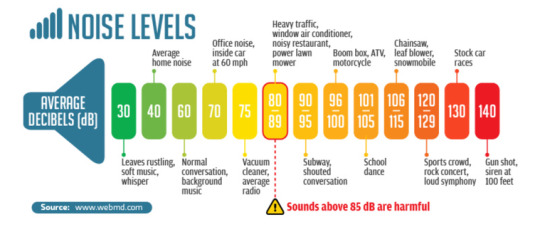
Image credit: soundear.com
Notice that louder sounds are more likely to damage our ear. That's because when loud sounds reach our ear, it causes the inner components to vibrate. This vibration amplitude generally is proportional to the amplitude of the waves.
Too loud of a sound means that our eardrums are vibrating with too great of a physical movement. This can create tears in tissue that damage our ears' sensitivity to sound.
Sound looses power over distance
If you stand far away enough from a sound source, it sounds fainter, eventually becoming unhearable.
This is because of the inverse square law. As sound spreads out over distance, it has to emanate in the form of a sphere, going outward in every direction, in order to maintain consistency of direction.
The same amount of power gets spread thinner and thinner over the bubble that it creates. The surface area of a sphere increases to the square of it's radius.
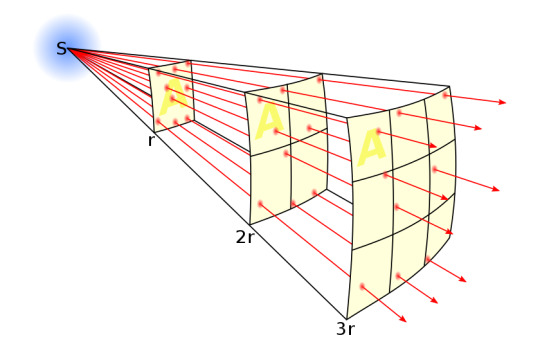
Image Credit: Wikipedia
Thus we get a decrease in volume over time.
What the Actual Fuck is Timbre, and how do you pronounce it? (also Texture too)
Unfortunately I still don't know how to pronounce it.
Timbre is defined as the quality and the colour of the sound we hear. It also includes the texture of the sound. It's sort of the catch-all for every other phenomena of sound.
Timbre is a bit more complex of a phenomena. In that, it combines basically everything else we know about how we hear sound. So I'll go one by one and explain each component of what makes Timbre Timbre.
Interference
Wave interference is an important property that needs to be understood before we actually talk about timbre. Sound waves often can overlap eachother in physical space, normally caused by multiple sound sources being produced at different locations.
These sound sources often will create new shapes in their waveform, via interference.
Constructive interference is when the high-pressure zones of two sound waves combine to produce an even-higher-pressure zone of wave. Effectively pressure gradient add onto eachother.
Destructive interference is when a high-pressure zone overlaps with a low-pressure zone, causing the pressure to average out to baseline, or something close to the baseline.
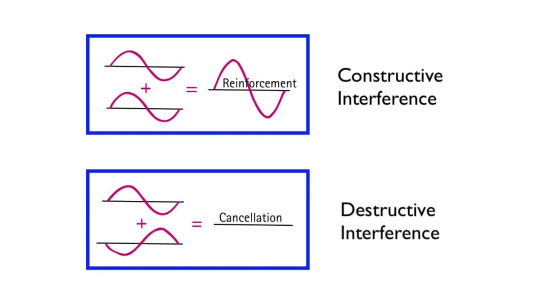
Image Credit: Arbor Scientific (Youtube)
We can look at multiple waves acting continuously over a medium to see how their amplitudes will add up together using interference. This is the origin of more unique wave patterns.
The shape of a wave
Sound waves can come in different varieties. While the most basic shape is the sine wave. We can add different intensities, frequencies and phases of sine waves to produce more complex patterns.
I won't go into how this combination works because that's better left for a Fourier series topic. Just know that pretty much any sound can be broken down into a series of sine waves.
These patterns have a different texture, as they combine multiple different monotone sounds. Take a listen to a sawtooth wave vs a sine wave:
Warning: the sawtooth wave will sound a lot louder than the sine wave.
This gives us a different sound texture.
Resonance
When you play a musical instrument at a particular frequency, the instrument is often resonating.
Say you produce sound within an enclosed box. Producing it at one end. Eventually the sound will reach the end of the box and bounce back from reflection (as we'll see later).
The sound will bounce back and forth, combining itself with the previous waves to produce more and more complex waveforms.
But there is a particular frequency, at which, the waves will perfectly interfere with eachother to produce what's known as a standing wave.
A standing wave will oscillate, but it will appear as if it's not moving forward. Of course, power is still moving throughout the wave, as we'll still be able to hear something.
This standing wave can only occur at a particular frequency, one in which the wave perfectly interferes with it's reflection within the box.
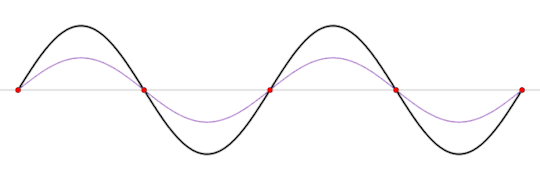
A standing wave (black) that is produced by two sine waves (blue and red) moving in opposite directions Image source: Wikipedia
This frequency is called the resonant frequency of the box. This frequency depends on several factors like the speed of the wave, the material inside the box, the shape of the box, and the length of the box.
The resonant frequency can be activated by our voices, as our voices or just blowing air is already a combination of different sound frequencies. The non-resonant frequencies will eventually loose all of their power as they destructively interfere, leaving only the resonant frequency, which gets amplified by what we put in
For example, you can fill a glass bottle halfway with some water, blow in it, and it will produce a particular sound. Fill it with more water, and the pitch increases - i.e. by adding the water we increase the resonant frequency.
All instruments have one or more resonant frequencies based on their material and shape (I say multiple because some instruments can me modelled as multiple boxes. Like a violin will have the inside of the wood, the wood itself, the strings, etc.).
Instruments also allow us to alter the resonant frequency by playing it differently (like putting a finger over your recorder's hole (phrasing)).
These differences in how we obtain resonance can also affect the quality of the sound.
Overtones
Resonance is not just generated with a single resonant frequency, we can create resonance with higher multiples of the the same fundamental frequency.
This is because in our box model, multiplying the fundamental frequency will allow us to create a standing wave, just with a shorter wavelength:
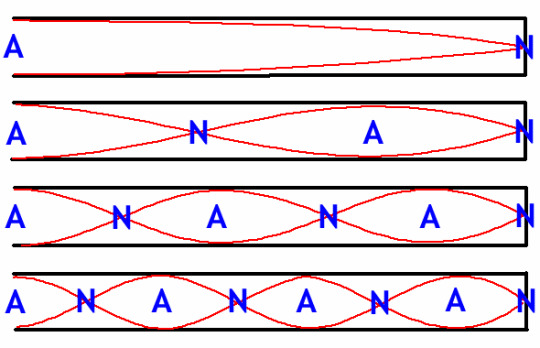
The A's stand for antinodes, which vibrate in the standing wave with the maximum amplitude. The N's stand for nodes, which do not move at all.
Image Credit: Macquarie University
Direct multiples of the fundamental frequency are called harmonics. Instruments can also produce other frequencies not directly harmonic depending on the structure of the 'box' they utilise.
These additional frequencies, ones which come often in fractional multiples of the fundamental are called partials. Both partials and harmonics represent the overtones of an instrument.
Overtones are what give sound additional character, as they allow instruments to not just resonate at the note they play, but at other combined frequencies. In some instruments, the overtones dominate over the fundamental - creating instruments that can play at much higher pitches.
Envelopes and Beats
Say we add two sine waves together (red and blue), each with slightly different frequencies, what we get is this:
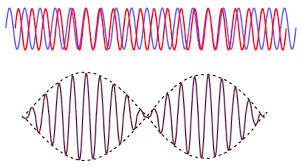
Image Credit: HyperPhysics Concepts
We can see that the brown wave has a singular oscillation frequency, but also it's amplitude continuously scales with reference to this hidden envelope frequency, called the beat frequency (dotted line).
This difference between the actual wave's real frequency and the wave's overall frequency envelope. Is another source of timbre.
Notes, and the way we play them will often generate unique and different envelopes depending on how they are played. For example a staccato quarter-note will have a different envelope to a softly played quarter-note.
Other properties of Sound
Reflection
Different mediums mean different speeds of sounds e.g. molecules in wood (solid) are harder to move than molecules in air (gas).
These different speeds create several effects. Including the reflection of waves. Often waves require a bit of power in order to physically overcome the resistances to vibration of a particular medium.
Often this leads to sound waves bouncing back off harder-to-traverse surfaces.
Say that a sound wave travels through the air and reaches a wooden wall. The atoms vibrating in the air will hit against the wooden wall, transferring only some of their energy to the resistant wood.
The wood atoms on the border of the wall will bounce back, as expected. But this time they will transfer energy back into the air at a much greater magnitude due to newton's third law.
Thus while some of the sound wave ends up going deeper into the wood, the wood will push back and cause the air to vibrate in the opposite direction, creating a reflected wave.

Image credit: Penn State
We characterise the amount of power being reflected versus transmitted versus absorbed using portions:
A + R + T = 1
A = Power absorbed into the material (e.g. warms up the material)
R = Power reflected back
T = Power transmitted into the new medium
This is both an explainer as to why rooms are both very good, and very bad at keeping sound inside them. It really depends on the rigidity and shape of the material they are bordered by.
Refraction
Just like light, sound waves can also refract. Refraction is actually a lot simpler to understand once you already realise that waves will both reflect and transmit across medium changes.
Refraction is just combining the results of incomplete reflection (i.e. transmission) with some angle.
I won't go into refraction in too much detail, as it's worth a different topic. But effectively we experience snell's law but modified for sound.
Diffraction
Sound waves, like all waves propagate spherically (or circularly in 2D).
When travelling around corners, sound can often appear louder than if you were further away, looking at the source more directly.
This is because spherical waves will often 'curve' around corners. This is better described by light diffraction. Which is something for another time.
Conclusion
In conclusion, that's how sound works, mostly. This is a topic that is a little less closer to my expertise. Mainly because it delves into more musically-inclined phenomena that I am less familiar with. But I'm sure I did a good job.
Unfortunately, it seems like the plague of the long post is not yet over. Perhaps I need to get into a lot more specific topics to make things better for me and you (the reader).
Anyways, my exams are done. I am done. I do not have to do school anymore. Until I remember to have to get ready for my honours year (a.k.a. a mini-masters degree tacked on after your bachelor's degree).
Until next time, feel free to gib feedback. It's always appreciated. Follow if you wanna see this stuff weekly.
Cya next week where I will probably try another astronomy topic, or something like that.
90 notes
·
View notes
Note
8. Least favorite notation you’ve ever seen?
12. Who actually invented calculus?
52. Do you have favorite math textbooks? If so, what are they?
57. What inspired you to do math?
:)))
From Real's Math Ask Meme.
8. Least favourite notation you’ve ever seen?
Writing a tensor product of bra-ket vectors as |1⟩|2⟩ instead of |1⟩⊗|2⟩, which was standard in the quantum information theory course I took (with @floralfractals :^)) a few years back. This makes an expression like ⟨1|⟨2||3⟩|4⟩ ambiguous! It evaluates to ⟨1|3⟩⟨2|4⟩ if you interpret the juxtaposition as a tensor product, and to ⟨1|4⟩⟨2|3⟩ if you intepret it as scalar multiplication.
10. Who actually invented calculus?
I did! Or I will have done, when I invent my time machine to travel back to the Islamic Golden Age to tell Al-Khwarizmi about category theory. Then they'll all see.
44. Do you have favourite math textbooks? If so, what are they?
I never stick with textbooks long enough for these to be like super well-founded recommendations, but I quite like Jonathan Gleason's Introduction to Analysis, Peter Johnstone's Stone Spaces, and Bochnak, Coste, & Roy's Real Algebraic Geometry.
49. What inspired you to do math?
So besides the fact that from a young age I was intrigued and engaged by puzzles and problem solving, it took quite some time before I realized I wanted to become a mathematician. Sometime during my fourth or fifth year of secondary school we covered logarithms, and that's when it all started to click for me. How addition, multiplication, exponentiation are just operations, and that they can have inverse operations, and that these are all examples of the exact same phenomenon. I started watching Vsauce and Numberphile and Vihart, and the rest is history.
#math#ask meme#proud of myself that i typed those authors and titles off the top of my head lol#vsauce's videos on the banach tarski paradox and transfinite cardinals were particularly influential on young rosie
7 notes
·
View notes
Text
Wordplay: Using doublespeak to manipulate your readers!
Doublespeak distorts, like a cuttlefish squirting ink. It makes the bad seem good, the negative positive, the unpleasant attractive.
It frames reality in a different way than it really is. For example, reframing an act of war as a “defensive freedom” and a “necessary action to protect our way of life”.
Types of Doublespeak:
Euphemism: Using mild or vague terms to mask harshness or unpleasantness.
Example: Referring to tax increase as “revenue enhancement”, shellshock as “”operational exhaustion”.
Jargon: Using special(pretentious, obscure) language that confuse, and exclude those not familiar with the terms.
Example: “The machine has a baseplate of prefabricated amulite, surmounted by a malleable logarithmic casing.”
Gobbledygook: Using complex, convoluted language to appear sophisticated and official.
Example: Instead of saying “We are cutting costs”, say “In alignment with our strategic operational objectives, we are initiating a paradigm shift in our financial allocation protocols to optimize resource utilization and enhance fiscal prudence across all departments.”
Inflated Language: Using grand words to make things appear more significant.
Example: Referring to a janitor as a “sanitation engineer”.
With doublespeak, deceptive language is normalized, politicians don’t lie but misspeak, illegal acts are inappropriate actions, and a fraud is a miscertification.
“If thought can corrupt language, then language can corrupt thought.” -George Orwell.
The above is my summary of this video: https://www.youtube.com/watch?v=CzsEp_hakK4
I like the concept of doublespeak, reframing, and tuning words to convey same-ish, yet different meanings.
Wordplay! Love it!
14 notes
·
View notes